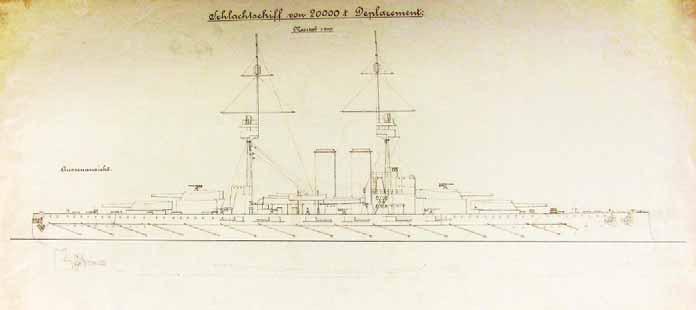Each boiler room had its own funnel. The transverse watertight bulkhead which divided the two boiler rooms was the most critical bulkhead of the ship because it had the largest surface area and watertight doors were cut in it which further weakened its structure. The ships could carry 1600 tons of coal and 150 tons of fuel oil which enabled a maximum range of 5200 nautical miles at a cruising speed of 10 knots. The ships could carry 1360 tons of briquettes70 instead of coal. When using briquette the maximum range dropped to 4300 nautical miles. The Project of the Fourth Armored Cruiser From the mid-1890s starting with the Monarch class coast defense ships the Austro-Hungarian Navy built an armored cruiser in addition to each battleship (Panzerschiff ) class, so Austria-Hungary followed the 3+1 building scheme, while Germany followed the 2+1 scheme. The first Austro-Hungarian armored cruiser was the 5,200 ton Kaiserin und Königin Maria Theresia which was built prior to the Monarch class. She would have been originally the third unit of a class of three 4,000 ton unarmored cruisers, but her design was modified and her displacement was enlarged. The second armorxíed cruiser was the 6,300 ton Kaiser Karl VI. She was built together with the Habsburg class. The third armored cruiser was the 7,400 ton Sankt Georg, the “fast wing” of the Erzherzog Karl class. In the case of the last two ships their design were made by the same boards at the same time as the design of their respective battleship classes.71 The new armored cruiser, officially designated as Rammkreuzer F (ram cruiser)72 would have been the companion of the Schlachtschiff I-III class. As in the case of the two preceding armored cruisers the design works of the fourth armored cruiser were made by the same boards and at the same time as the works of the new battleship class. Being not a colonial power and possessing a relatively small merchant fleet,73 Austria-Hungary had only three armored cruisers, while Italy, which had colonial ambitions in North Africa, had ten. Austro-Hungarian armored cruisers had the same caliber main guns (24 cm) as their battleship companions and had the thickest possible armor protection. It is clearly visible that they were intended
to be used in the battle line instead of being protectors of trade or commerce raiders. Their main wartime purpose was to complete the numerically inferior battleship squadrons forming a “fast wing” of the battle line. In peacetime they executed diplomatic missions. The original specifications for the fourth Austro-Hungarian armored cruiser were 8,000 tons displacement and 23 knots design speed. The design speed of the preceding armored cruiser, Sankt Georg was 21 knots. At the board meeting held on 25 September 1905 Kontreadmiral Ripper proposed a uniform armament of twelve 19 cm/45 guns. He said that in contrast to the Sankt Georg the new ship had to have a symmetrical armament and the weight of the armament could not exceed the weight of the Sankt Georg’s considering the design speed of 23 knots. Popper remarked that this armament would have been too heavy considering the desired speed.74 At the meeting of 29 September Popper presented five alternative designs: The Armament of the Popper-designs75 (t=in turret, c=in casemate) A
4×2-19cm t
B
2×1-24 cm t, 6×19 cm c
C
2×1-28 cm t, 4×19 cm c
D
2×1-30,5 cm t, 4×19 c
E
2×2-19 cm t, 6×19 cm c
According to Popper’s calculations the displacements of these variant were between 8,500 and 9,000 tons. The displacement of variant D with torpedo bulkheads and 10.5 cm anti-torpedo boat battery would have exceeded 10,000 tons.76 Jedlička supported the variant B saying that 19 cm guns were useless against a ship with similar armor. Linienschiffskapitän Baselli supported the A variant with 10.5 cm anti-torpedo boat battery. Linienschiffskapitän Ziegler argued that only a wealthy navy could allow itself to build pure cruisers. A small navy on limited budget like the Austro-Hungarian had to use in the battle line their armored cruisers as the Japanese had done in 19041905. So he supported the variant B with 10.5 cm guns and torpedo bulkheads. Popper warned that
— 41 —






























